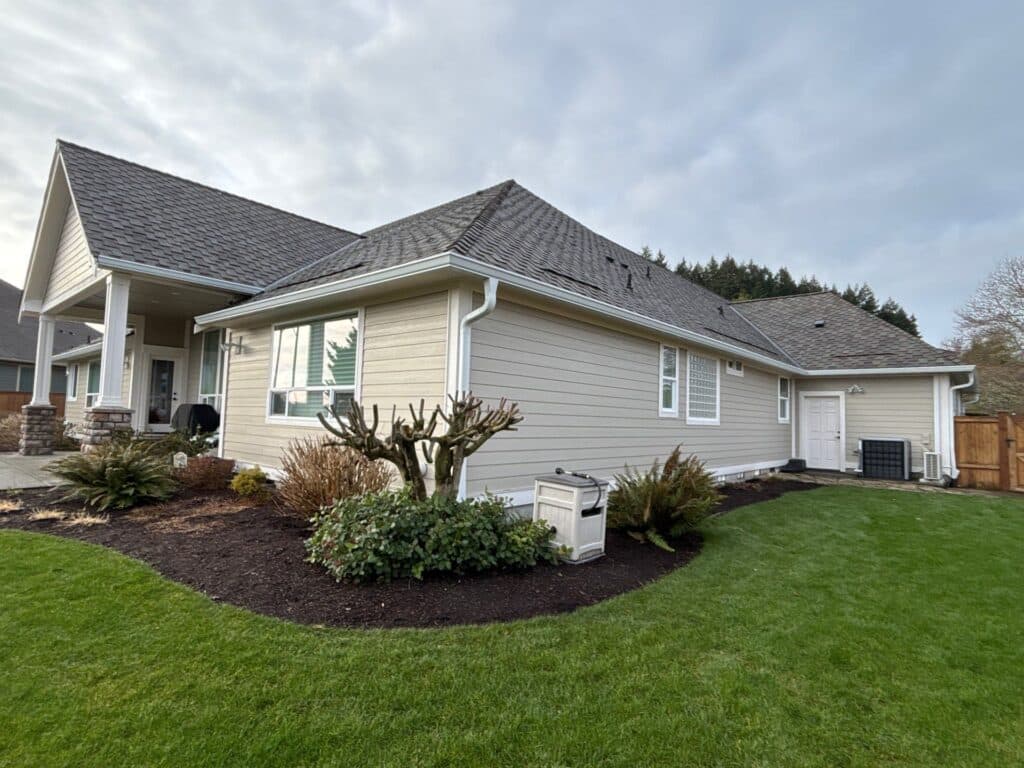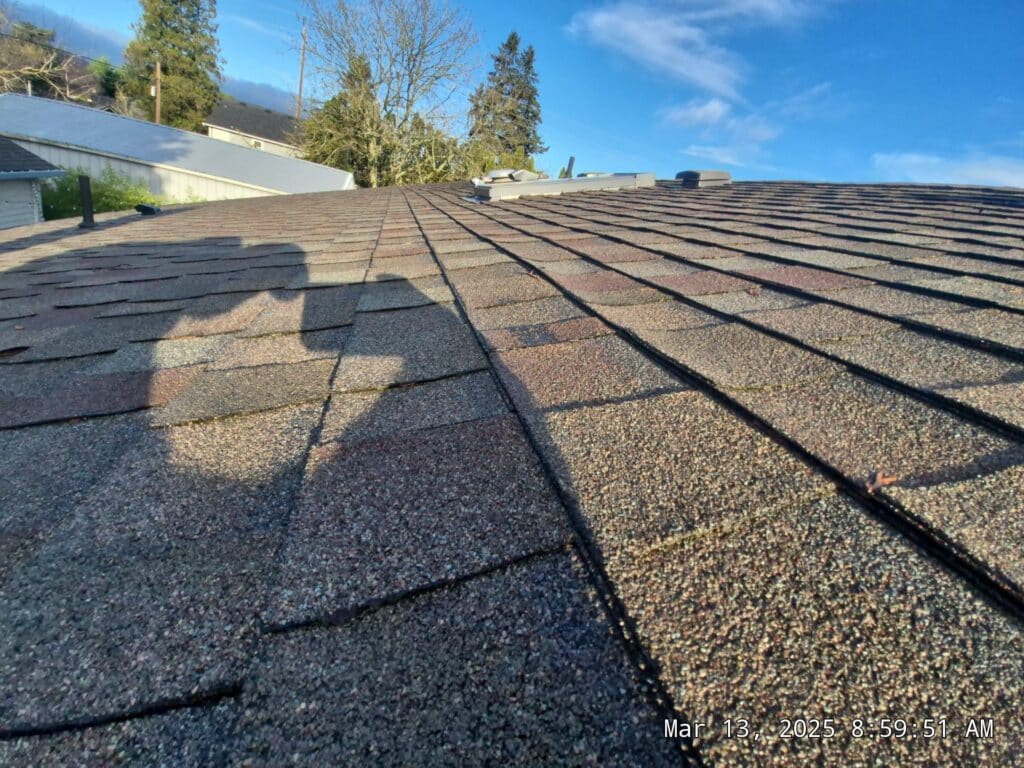Ever catch yourself staring at your roof and wondering… what are shingles actually made of?
You're not alone. Most of us don’t think much about what’s up there until a leak happens, shingles go missing, or it’s time for a roof replacement quote that makes you do a double take.
Here’s the deal: the materials your shingles are made of matter. They affect how well your roof holds up in bad weather, how long it lasts, and how much it’ll cost you over the years. And with all the different types of shingles out there, it helps to know what you’re looking at and what you’re paying for.
So if you’ve ever asked yourself, what are shingles made of, or wondered which type might be best for your home, you’re in the right place. In this post, we’ll break it all down: what shingles are made of, how they’re made, the most popular types, and even how some of them can be recycled.

If you're trying to figure out why some roofs seem to last for decades while others wear out fast, it all comes down to what the shingles are made of. Especially with asphalt shingles the most popular choice for homeowners there’s more going on than just what you see on the surface.
This is the layer that gives your shingles their shape and strength. Today, most modern shingles are made with a fiberglass mat because it's fire-resistant, durable, and holds up well in different weather. Older shingles used organic materials like paper or wood fiber, but they don’t offer the same level of reliability.
Think of it like the frame of your house everything else gets built on top of it.
Next comes the asphalt coating, which seals the mat and helps keep water out. It’s a key part of what makes asphalt roofing such a trusted option. When it rains, this layer works to stop moisture from seeping into your roof. It also keeps the shingle flexible, so it doesn't crack or split when temperatures swing.
Imagine your roof as a shield this is the layer doing most of the heavy lifting when it comes to waterproofing.
Those little colored bits on top of your shingles? They’re more than just for looks. Granules protect the asphalt from sun damage, help with fire resistance, and even come in reflective options that can make your home more energy-efficient. Some shingles may also have algae-resistant granules to prevent those dark streaks you see on older roofs.
If you've ever noticed how hot a car roof gets in the sun, you’ll appreciate how these tiny granules help your home stay cooler.
This is the part that bonds the shingles together. When installed, the sun activates a sticky strip that helps each shingle hold onto the next. That way, during high winds or storms, your shingles are less likely to lift or blow off.
Think of it like roofing glue that works automatically once it heats up it’s simple but effective.
You won’t see this once the shingles are on your roof. The release film is only there while the shingles are in the package. It stops the adhesive strip from sticking to the other shingles too soon. Once they’re installed, the film has done its job and doesn’t play a role anymore.
Basically, it keeps things neat during shipping, so your roofer doesn’t have a mess on their hands before the job even starts.
Did You Know?
Asphalt shingles are installed on more than 75% of U.S. homes as of 2024.
That’s not just a fun fact it tells you just how trusted this roofing material really is.
If you've ever held a roofing shingle, you might not think much of it but there's actually a lot going on in that single piece. The way shingles are made is a big reason why some roofs last longer and hold up better than others.
It starts with a base layer, usually fiberglass. This gives the shingle its strength, kind of like the bones of a house. That base gets soaked in asphalt, which is what makes it waterproof and able to take on weather without falling apart.
While it’s still hot, granules are pressed into the top. These are those gritty bits you can see and feel they give shingles their color, help block sunlight, and keep the asphalt from breaking down too fast.
Once that’s done, a strip of adhesive goes on. That’s what helps shingles stick together when they’re installed especially important when the wind picks up. After cooling, the shingles are trimmed, stacked, and packed up for delivery.
So next time you're on your porch during a rainstorm, just remember: your roof’s holding up thanks to a pretty smart manufacturing process.

Not all shingles are created equal and if you're looking at replacing your roof, it’s worth knowing what your options are. Here’s what homeowners are actually using, and why.
This is the most common roofing choice out there, and for good reason. They're simple, cost-effective, and they do the job well. You’ve probably seen 3-tab shingles or architectural shingles in your neighborhood already.
They’re great if you want a roof that goes on fast, lasts 20–30 years, and doesn’t require a ton of upkeep.
If you're going for that classic, natural look maybe for a cottage-style home or something with character wood shingles or shakes can be a good fit. They’re usually made from cedar and offer a lot of charm.
Just know they do take a bit more care, especially in areas with a lot of moisture or bugs.
Metal roofing used to be mainly for barns and industrial buildings, but it's become a stylish pick for homes too. It lasts a long time, holds up in storms, and reflects heat so it can help keep your home cooler in the summer.
If you're in an area that gets hail or high winds, this might be worth a closer look.
These are the premium picks. Slate and clay tile roofs look amazing, last pretty much forever, and are great if you're aiming for a more traditional or high-end aesthetic.
The tradeoff? They’re heavy so your home needs to be able to support the weight and they’re more expensive upfront.
Want the look of wood or slate without the extra hassle? Composite shingles are made from a mix of materials, and they’ve come a long way in recent years. They’re light, easy to install, and often made from recycled products, which is a plus if you’re thinking green.
They’re a smart choice if you want something low-maintenance but still stylish.
If you’ve been trying to figure out whether to go with composite or stick with traditional shingles, you’re not alone. It’s one of the most common questions homeowners ask during a roof replacement.
If you’re after a longer-lasting, low-maintenance roof and you’re okay spending a bit more upfront, they might be the better fit. But if you just need something reliable and budget-friendly, asphalt still gets the job done.
When it’s time for a new roof, the old one doesn’t have to end up in a landfill. That’s good news not just for the planet, but for anyone who wants to make smarter, more sustainable home choices.
Most asphalt shingles are made with materials that can actually be reused in things like paving roads. It’s a pretty cool process and it’s growing fast. In fact, recycling just one ton of shingles saves about a barrel of oil. Multiply that by a whole neighborhood, and you’re making a real difference.
If you're working with a roofing contractor, ask if they offer recycling as part of the removal process. Some cities even have drop-off locations. Plus, more shingle brands are now offering green certifications and reflective materials that help with energy efficiency.
Bottom line? If you're getting a new roof, it’s a chance to do something good without extra effort.
Not all roofs are built the same and where you live plays a big part in what works best. Here’s a quick look at what makes sense based on your climate:
It all comes down to choosing a roofing material that works with not against your environment.
Choosing a roofing material isn’t always simple but it matters more than you might think. Your roof does a lot: it protects your home, keeps energy costs down, and adds curb appeal whether you’re planning to stay or eventually sell.
In this post, we covered the basics of what roof shingles are made of, how they’re built, and the pros and cons of each type. From classic asphalt shingles to long-lasting slate or composite roofing, there’s no one-size-fits-all answer but there is a choice that fits your home, your climate, and your plans.
If you're still not sure which roofing option makes the most sense for you, or if you'd like to talk through your options with someone who’s seen it all, reach out to the team at IBEX Roof. We’ll walk you through what works best based on your needs, location, and budget.
Still have questions or ready to get started? Let’s talk contact us today for a free consultation and feel confident in the roof over your head.